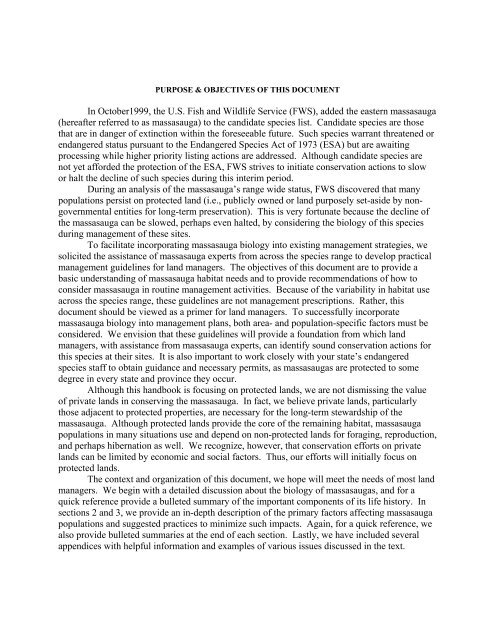The Eastern Massasauga Rattlesnake: - U.S. Fish and Wildlife Service
The Eastern Massasauga Rattlesnake: - U.S. Fish and Wildlife Service
The Eastern Massasauga Rattlesnake: - U.S. Fish and Wildlife Service
You also want an ePaper? Increase the reach of your titles
YUMPU automatically turns print PDFs into web optimized ePapers that Google loves.
PURPOSE & OBJECTIVES OF THIS DOCUMENT<br />
In October1999, the U.S. <strong>Fish</strong> <strong>and</strong> <strong>Wildlife</strong> <strong>Service</strong> (FWS), added the eastern massasauga<br />
(hereafter referred to as massasauga) to the c<strong>and</strong>idate species list. C<strong>and</strong>idate species are those<br />
that are in danger of extinction within the foreseeable future. Such species warrant threatened or<br />
endangered status pursuant to the Endangered Species Act of 1973 (ESA) but are awaiting<br />
processing while higher priority listing actions are addressed. Although c<strong>and</strong>idate species are<br />
not yet afforded the protection of the ESA, FWS strives to initiate conservation actions to slow<br />
or halt the decline of such species during this interim period.<br />
During an analysis of the massasauga’s range wide status, FWS discovered that many<br />
populations persist on protected l<strong>and</strong> (i.e., publicly owned or l<strong>and</strong> purposely set-aside by nongovernmental<br />
entities for long-term preservation). This is very fortunate because the decline of<br />
the massasauga can be slowed, perhaps even halted, by considering the biology of this species<br />
during management of these sites.<br />
To facilitate incorporating massasauga biology into existing management strategies, we<br />
solicited the assistance of massasauga experts from across the species range to develop practical<br />
management guidelines for l<strong>and</strong> managers. <strong>The</strong> objectives of this document are to provide a<br />
basic underst<strong>and</strong>ing of massasauga habitat needs <strong>and</strong> to provide recommendations of how to<br />
consider massasauga in routine management activities. Because of the variability in habitat use<br />
across the species range, these guidelines are not management prescriptions. Rather, this<br />
document should be viewed as a primer for l<strong>and</strong> managers. To successfully incorporate<br />
massasauga biology into management plans, both area- <strong>and</strong> population-specific factors must be<br />
considered. We envision that these guidelines will provide a foundation from which l<strong>and</strong><br />
managers, with assistance from massasauga experts, can identify sound conservation actions for<br />
this species at their sites. It is also important to work closely with your state’s endangered<br />
species staff to obtain guidance <strong>and</strong> necessary permits, as massasaugas are protected to some<br />
degree in every state <strong>and</strong> province they occur.<br />
Although this h<strong>and</strong>book is focusing on protected l<strong>and</strong>s, we are not dismissing the value<br />
of private l<strong>and</strong>s in conserving the massasauga. In fact, we believe private l<strong>and</strong>s, particularly<br />
those adjacent to protected properties, are necessary for the long-term stewardship of the<br />
massasauga. Although protected l<strong>and</strong>s provide the core of the remaining habitat, massasauga<br />
populations in many situations use <strong>and</strong> depend on non-protected l<strong>and</strong>s for foraging, reproduction,<br />
<strong>and</strong> perhaps hibernation as well. We recognize, however, that conservation efforts on private<br />
l<strong>and</strong>s can be limited by economic <strong>and</strong> social factors. Thus, our efforts will initially focus on<br />
protected l<strong>and</strong>s.<br />
<strong>The</strong> context <strong>and</strong> organization of this document, we hope will meet the needs of most l<strong>and</strong><br />
managers. We begin with a detailed discussion about the biology of massasaugas, <strong>and</strong> for a<br />
quick reference provide a bulleted summary of the important components of its life history. In<br />
sections 2 <strong>and</strong> 3, we provide an in-depth description of the primary factors affecting massasauga<br />
populations <strong>and</strong> suggested practices to minimize such impacts. Again, for a quick reference, we<br />
also provide bulleted summaries at the end of each section. Lastly, we have included several<br />
appendices with helpful information <strong>and</strong> examples of various issues discussed in the text.

















